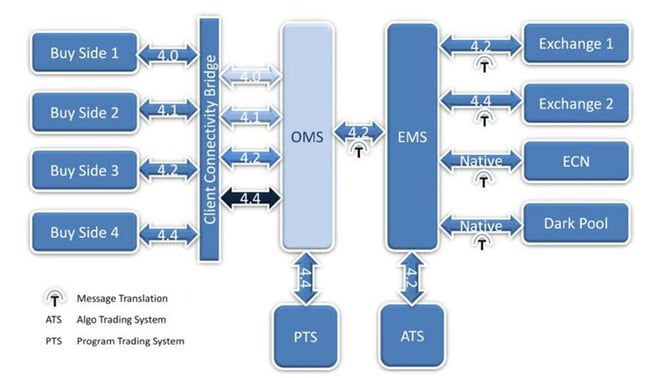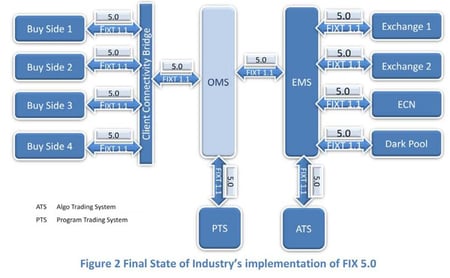5 min read
What is FIX?
By Carlyle GordonThe intention of this article is to explain what the FIX Protocol is to someone who is not familiar or only has a vague familiarity...

 Early FIX solutions
Early FIX solutionsThe FIX Protocol has evolved from supporting equities to supporting messaging requirements of multiple asset classes, including derivatives, fixed income and foreign exchange.
The explosive growth of use of FIX, facilitated by the flexibility it presents, the parallel growth and use of proprietary application programming interfaces (APIs) by the exchanges, met the industry's immediate needs for business growth. At the same time, the earlier versions necessitated certain costs on maintenance, interconnectivity and language translators.
The flexibility to create custom tags, met the needs of individual firms, however, this practice can also lead to the generation of non-standard versions of the protocol and its widespread use can result in higher costs of implementation and a longer time for deployment for the industry. Also, the tight coupling of the application layer and the business layer in FIX4.X versions limited the ability to adapt to newer functionalities offered by later FIX versions.
The industry as a whole needed to address the limitations of the existing protocol as well as find a protocol flexible enough to support their future requirements. FPL came together to address the dual needs of its members and the outcome was FIX 5.0 and FIXT.1.1, the FIX Session Protocol, as an answer to its members’ requirements.
Transport independence disconnected business messages from their carrier thereby allowing different versions of FIX Protocols to be run on the same session via any appropriate technology, in addition to the FIX Session Protocol. This feature helped reduce technological constraints and made it possible for firms to communicate with each other regardless of their FIX version. This is possible because FIX 5.0 runs on top of the FIX Session Protocol. Transport independence serves the industry’s need to use the existing FIX versions and also help firms reduce the future cost of implementing new FIX versions.

The regular release of extension packs, which offer additional functionality and are available for adoption as soon as they are developed, incorporate new functionalities and message tags, which encourage standardization at the industry level and discourages members from having to develop non-standard custom tags. Also, separate release and versioning of the packs for application layer and session layer allows foraddressing requirements specific to application and session layer.
While the market participants are well defined by their roles and functions, the multitude of protocols (proprietary and industry standard) and their non-uniform adoption creates complexities that the members need to address in order to conduct business seamlessly.
FIX 5.0 and FIXT.1.1 give the industry an opportunity to transform their communication and messaging infrastructure, reaping the benefits of reduced cost of maintenance of bespoke versions, improved connectivity and interoperability between counterparties, lower costs in testing and faster roll out, bandwidth conservation, latency reduction, automation and straight through processing (STP). Since FIX is only prescriptive and not mandatory, market participants are free to choose their adoption based on their individual business requirements and priorities. While each market participant has its own strategy for the use of protocols, it is evident that a collective industry effort would yield maximum benefit for participants.
In the following section, we look at various strategies industry participants might follow in the adoption of FIX 5.0.

Exchanges are proactively looking to retain and grow trade volumes by providing clients rich functionalities, low latency and greater market depth at lower transaction costs. FIX 5.0 can form an integral part of the strategy of maintaining leadership by providing benefits to clients that are in the process of implementing FIX 5.0 and also to those clients using legacy FIX versions for connectivity, thereby enabling quicker, more cost effective integration of communication channels. Exchanges/liquidity centers can fully migrate from earlier versions of FIX and non-FIX protocols and phase out their proprietary protocols. We have already seen progress on this strategy with leading exchanges such as BSE rolling out a FIX 5.0 compliant interface.
Sell-Side
It is important for sell-side firms to not only look forward to maintaining state of the art exchange connectivity infrastructure for better price discovery and distribution, but also to look internally for improvements in their core trading platform infrastructure, for supporting higher volume, lower latency and fewer trade errors.
Implementation of FIX 5.0 can help lower latency on account of fewer message translations and lower trade errors. However, changing the core trading infrastructure is not easy, as a typical sell-side firm will have a plethora of systems, both off-the-shelf and proprietary, that communicate in various versions of FIX. Hence, the sell-side firms can adopt a “Session Migration” approach to FIXT.1.1. This will allow firms to first connect internal systems running FIX 4.X over FIXT.1.1, thereby benefiting from the transport independence framework.
In the long run, sell-side firms can migrate to FIX 5.0 to fully benefit from the rich business functionalities offered by the protocol as well as achieve adoption of a single protocol that caters to internal and external systems.
Buy-Side
The buy-side need for best execution is met by its ability to connect and transact either directly at points of liquidity or through the sell-side. A wider access to the sell-side and the points of liquidity improve the buy-side’s ability to transact at ‘Best Price.’
Typically, the buy-side systems interface or use sell-side’s infrastructure to transact. It is likely that buy-side firms would prefer to use services of sell-side firms which use FIX 5.0
compliant systems in order to benefit from reduced latency. Direct Market Access (DMA) is likely to be first the infrastructure to undergo this change. In the long run the, buy-side can slowly adopt a migration approach similar to the sell-side i.e. “Session Migration” followed by a “Protocol Migration” to FIX 5.0 in order to benefit from its rich business functionalities.

Conclusion
As the momentum of industry participants moving toward FIX 5.0 gains ground, the industry as a whole will gain from the experience of implementation, reduction in cost of implementation and the availability of off-the-shelf solutions. This will further accelerate adoption across the industry as participants realize benefits through a reduction in costs achieved by a rationalization of communication protocols used to communicate, transact, process, and settle large volumes of trades across asset classes. This will be fully realized when the buy-side, sell-side and points of liquidity communicate seamlessly over FIX 5.0.

5 min read
By Carlyle GordonThe intention of this article is to explain what the FIX Protocol is to someone who is not familiar or only has a vague familiarity...

3 min read
Bob Caisley, CIO of the Singapore Stock Exchange (SGX), recounts the reasons why SGX is adopting FIX 5.0

6 min read
Bank of America Merrill Lynch’s Josephine Kim lays out the reasons why the close price benchmark is so important and how experienced traders can...